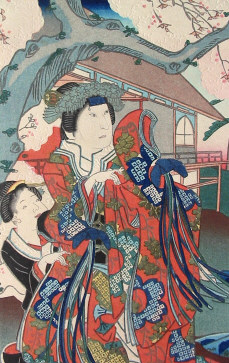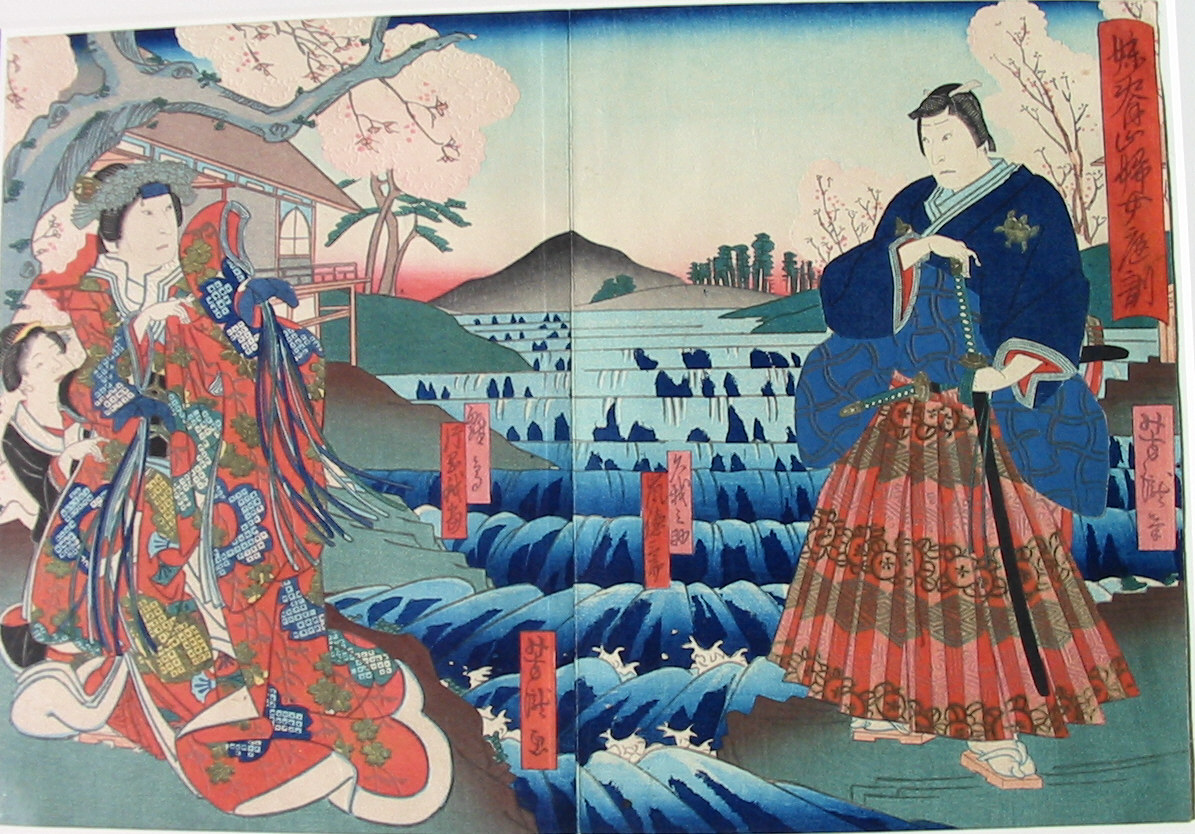 |
JAPANESE PRINTS
A MILLION QUESTIONS
TWO MILLION MYSTERIES
Ukiyo-e Prints浮世絵版画 |
|
Port Townsend, Washington |
| Utagawa YOSHITAKI |
| 歌川芳滝 |
| うたがわよしたき |
| 1841-1899 |
| Scene from the play "Imoseyama Onna Teikin" |
| 妹背山女庭訓 |
| いもせいやまおんなていきん |
|
Arashi Tokusaburo IV (嵐徳三郎 or あらしとくさぶろう) - on the right - as Koganosuke (子久之助 or こがのすけ) and Kataoka Gado II (片岡我童 or かたおかがどう) as Hinadori (雛鳥 or ひなどり) |
| Date: 1864 |
| Combined Diptych Print Size: 9 1/2" x 13 7/8" |
|
SOLD! |
|
|
 |
||||
|
The drama of this scene from the kabuki play Imoseyama Onna Teikin is immediately obvious, but without a knowledge of the theme a complete understanding is not.
|
|
Hinadori and Koganosuke are in love with each other and are separated not only by the physical barrier of the Yoshino River, but also because of a rivalry between their families. However, one thing the families have in common is their loyalty to the emperor. This becomes a significant factor when Soga Iruka, the chief minister, makes a power play to usurp the throne. Knowing that Iruka is smitten with Hinadori's beauty her parents send her to their palace on Imoyama using the excuse that she is ailing. But Iruka will not be deterred and declares that not only is Hinadori to become his concubine, but Koganosuke is to serve as his retainer. (Koganosuke is already in hiding at the country palace on Seyama to avoid Iruka's wrath from an earlier incident.) This pressure helps bring the two families closer to a reconciliation. "If Hinadori consents, [her] mother is to throw a branch of flowering cherry into the river; if she refuses, a dead branch. The same signal is to be made by the father for the boy."
Koganosuke decides that he can not serve Iruka and therefore commits seppuku. "Before he dies he asks his father to fling a flowering branch of cherry into the river so that Hinadori may not be grieved by the knowledge of his death." On the other side of the Yoshino Hinadori is told to prepare for her marriage to the chief minister. Miserable she sits before her doll collection which she has been displaying for the hina-matsuri or girl's festival. As she lets down her hair with tears in her eyes she looks with envy upon the peacefulness of her dolls. Carelessly she knocks the dolls from their stands and the head of one of them roles across the floor. Taking this as a symbol Hinadori begs her mother to behead her. But before she dies she tells her mother to throw a flowering cherry branch into the Yoshino so Koganosuke will not know of her death.
After both of the lovers have died the families decide to reunite them in a posthumous marriage. Hinadori's head along with her some of her dolls is placed on her inverted koto and floated across the Yoshino to be joined with the body of Koganosuke.
|
|
The quotes above come from The Kabuki Handbook by Aubrey S. and Giovanna M. Halford, published by Charles S. Tuttle, 1990. |
|
|
|
One of the most striking elements of this chuban diptych is the dramatic display of the Yoshino River. Samuel Leiter in his New Kabuki Encyclopedia reproduces on page 218 an illustration of "The wave-roller effect for the Yoshino River, seen from backstage. (From Oky˘gen Gakuya no Honsetsu, 1858)." |
 HOME
HOME |
